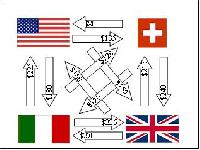
Globalization shows that MNCs are operating in different countries by setting up affiliates, subsidiaries etc. The operation of MNCs indicates that there are greater volume of transactions within a firm. Firms may be purchasing components and other semi finished products from their affiliates. Some estimates say that nearly 60 per cent of international transactions are intra-firm transactions.
Then, how a firm will charge price for a component when it is purchasing that product from its close affiliate?
Here comes the relevance of transfer pricing.
Transfer pricing is the price paid by a firm for a good or service while purchasing it from a related entity. It refers to the setting, analysis, documentation, and adjustment of charges made between related parties for goods, services, or use of property (including intangible property like IPRs).
When a firm is buying or selling from its relative entity, there are chances that prices may not be fixed not according to the market principles. Rather price may be decided artificially by the parent company with a view to get maximum benefits, as well as to avoid tax payments. This artificially price setting in intra-firm transactions to avoid taxes and to get other benefits is called transfer mispricing.
Transfer mispricing, or transfer pricing manipulation refers to trade between related parties at prices meant to manipulate markets or to cheat tax authorities. Often, avoidance of taxes is the main purpose of transfer mispricing.
For example, suppose that a Company producing cars has its HQ in Japan, and subsidiary in India. Besides, imagine that for the year, the Japanese operations have losses whereas the Indian subsidiary has profits. Here, if the Indian subsidiary purchases a component from Japan parent by recording it at a high price, it is good for the company as a whole. The profit of the Indian operations will come down (due to higher price). Hence, its tax outgo will come down. Similarly, the loss of the Japanese firm declines. The result is that the company as a whole including its parent and subsidiary has benefited by paying less taxes.
Governments have also devised many measures to avoid the misuse of transfer pricing. One such method is the adoption of arms length principle for intra-firm sale of goods and services. Similarly, safe harbor rules are designed to eliminate transfer mispricing. Advance pricing agreement is another measure to check transfer mispricing.
*********









